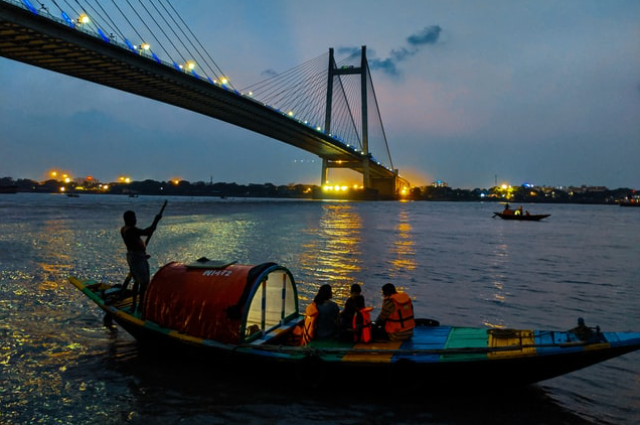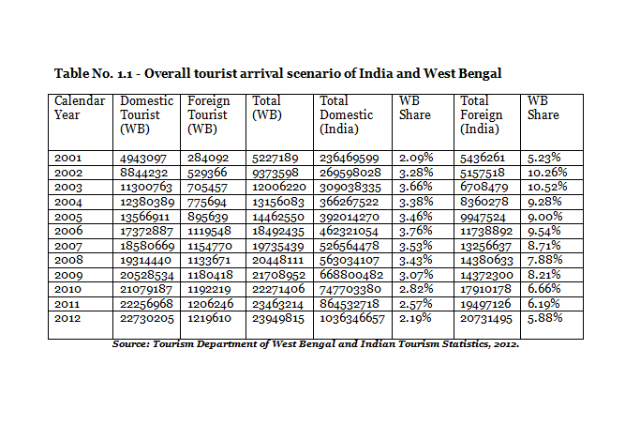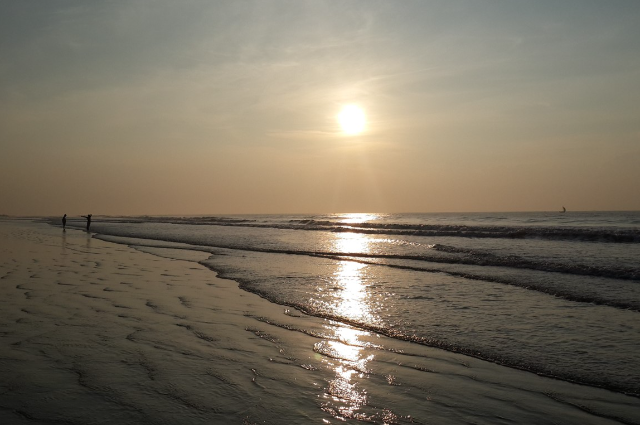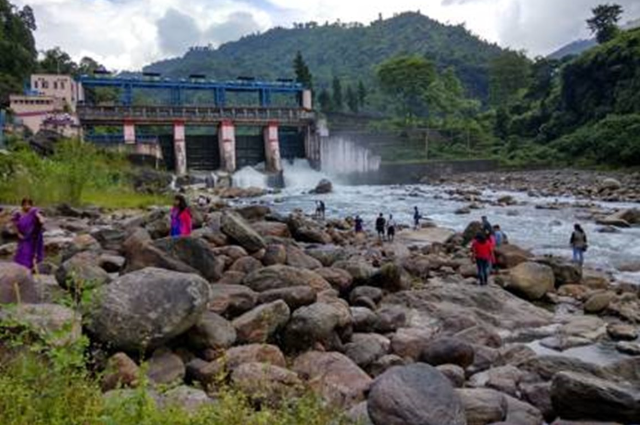
Introduction
1.1 Conceptual Framework
In the words of Hunziker and Krapf (1941): “tourism is the sum of the phenomena and relationship arising from the travel and stay of non-residents who are not connected with any earning activity”. Tourism has been evolved as an industry after the industrial revolution. From leisure, tourism has strengthened itself in the social life of its stakeholders – both guests and hosts. Tourism satisfies what Bertrand Russell has said: “The art of using one’s leisure intelligently is a supreme sign of civilization”. : Tourism, environment and economy are found intricately related. A high quality of environment is the basic for the development of tourism in an area. The natural environment has to be checked in terms of its physical characteristics such as vegetation, climate, soil, fauna and flora. It will also study the dynamics of relationships between their features. As the environment is the prime resource of tourism, the increasing tourism activities in tourist destination often may result into the deterioration and degradation of the environment. This may occur due to the unscientific and unplanned growth of tourism in that area. The environmental changes associated with tourism development mainly focus on the land and landscape both man-made as well as natural environment.
A destination environment in all its forms is a major motivating factor for the initial visitors’ interest in a host area. If there is any deterioration in the quality of environment, the tourism development is affected. Depending on the environmental factors tourism can be divided into two broad categories, viz. (i) mass tourism (ii) sustainable tourism or eco-tourism. The unplanned or unscientific way of tourism development gives birth to mass tourism that results into scattered development affecting environment while sustainable tourism deals with the development that has been carefully planned and organized. Sustainable tourism also focuses on the greater realization of the carrying capacity of the tourism destination. Carrying capacity represents the point beyond which the tourism of an area becomes unsustainable posing threats for environment. Every tourist region has a carrying capacity. The longevity and the sustenance of tourism regarding the sustenance of host environment rely on the environmental sustainability.
The development in tourism sector is an area invariably leads to economic growth of that area. The gradual growth in economy is manifested in terms of increase in income, poverty alleviation, employment opportunities, infrastructural growth, improvement of the standards of living etc. Fortunately tourism has variety of economic impacts. The travel and tourism contributes to sales, profits, jobs, tax revenues and income of the area. There are three effective areas where the role of tourism is vital for economy- Direct, Indirect and Induced effect.
The effect occurs directly within the primary tourism sector- lodging, food and beverage industry, transportation, amusements and retail trade.
The indirect effects occur when tourism affects various sectors of economy viz industries supplying products and services to hotels.
The effect on tourism activity normally focuses on changes in sales, income and employment in a region resulting from tourism activity.
1.2 Covid-19 affect in tourism industry:
The novel corona virus disease was first discovered in December 2019 in Wuhan, China. This pandemic caused due the novel corona virus disease has been rightfully labeled as a “Black Swan Event”. The SARS-CoV-2 is a new virus that causes covid-19 which severely damages the respiratory system. This fatal disease significantly expanded across world and compelled the World Health Organization to declare COVID-19 as a pandemic on 11th March 2020.
According to UN (United Nation), more than 90% of all worldwide destinations have introduced travel restrictions. This pandemic of COVID19 has impacted travel and tourism like no other event had done it before in the history. 100% of the travel destinations in Asia have adopted restrictions related to COVID19 since January, 2020. The World Travel and Tourism Council (WTTC) estimate the crisis to cost the tourism sector a minimum of US $22 billion, leading to a loss of fifty million jobs.
India got severely affected by the COVID19 pandemic and has paralyzed the economy of the country. The mostly affected sector is the tourism sector. This socio-economic catastrophy has devastated the tourism business, leaving travelers scrambling to return home and completely destroying the economies that are largely dependent on tourism. The national organization of IATO (Indian Associations of Tour Operators) estimated that the hotel, aviation and travel sector together may incur loss of about 85 billion due to travel restrictions. On account of Covid-19, the Indian tourism and hospitality industry will face employment loss of around 38 million.
Tourism and hospitality businesses are profoundly suffering from COVID-19 that has been declared as pandemic on 12th March 2020 (WHO, 2020). Thanks to the COVID-19 pandemic, the travel and tourism industry’s employment loss is predicted to be 100.08 Million worldwide (Statista, 2020). The pandemic has not only affected economically but also as politically and socially (Cohen, 2012). because the number of infected cases rising throughout the state , and with the implementation of certain measures and campaigns like social distancing, community lockdowns, work from home, occupy home, self-or mandatory quarantine, curbs on crowding, etc. pressure is made for halting the tourism industry/business (Gretel et al., 2020; Sigala, 2020). This alteration within the current system has led to the start of the recession and depression, seeking a transformational change in society. Consistent with Liu et al. (2019), the foremost dynamic sector is that the tourism industry that benefits many others sectors like lodging, catering, transportation, retail, entertainment, etc. contributing to economic process and recovery globally. It's been reported that tourism growth has outperformed the planet GDP growth record from the past consecutively from the year 2011–2017 (WTTC, 2018).
1.3 Tourism in India and West Bengal:

India, the land of ‘Unity in Diversity’ is a country with 15,200 kilometer land frontier and about 6000 kilometer coastline approximately. As a vast and diverse country, India is well endowed with natural tourism resources. In case of cultural richness, India has the most ancient cultural heritage. Epics like Mahabharata and Ramayana and the story of Lord Krishna in Bhagwata Purana lie in the core of Indian cultural heritage. The art, literature, music, beats and rhythms of folk and classical dances, and painting gives it a distinct allure. The architectural style of the shrines, the beauty of ancient monuments and architectural master pieces are also a great attraction. The entire diversified resource base makes the country a paradise for tourists.
After Independence, much more attention was paid to the development of tourism in India. In 2012, about 20.7 million foreign tourists visit India having an annual growth rate of 4.3%. The share of India in international tourists’ arrival has been 0.64% with the 41st rank while domestic visitors numbered 1036.35 million having an annual growth rate of 19.87% represent the present status of this industry in the country (Indian Tourism Statistics, 2012). The tourism industry contributes to Indian economy as Foreign Exchange Earner. In 2012, the Foreign Exchange Earnings (FEE) from tourism was ₹ 94487 crore (Indian Tourism Statistics, 2012). In case of West Bengal, an eastern state of India, the foreign tourist arrival in 2012 was 1.22 million with an annual growth rate of 0.52% while the domestic visitors numbered 22.73 million with an annual growth rate of 2.13%. The rank of West Bengal among all states has been 10th in domestic tourist arrivals and 6th in foreign tourist arrival.
Moreover, it has been estimated that there is a drop of international tourists of about 78%, causing a loss in export revenue of US$ 1.2 trillion and representing the largest decline within the tourism job cuts, which is about seven times the impact of the 9/11 incident (UNWTO, 2020). Additionally, the drop by the tourists’ demand has led to severe financial problems (Tsionas, 2020). Now, India may be a developing nation, known for its uniqueness in its tradition, culture and unparalleled hospitality. The tourism industry of India is often divided into three major segments, like (i) international inbound tourism; (ii) domestic tourism; and (iii) outbound tourism. The tourism industry of India has created about 87.5 million jobs, with 12.75% of total employment, thereby contributing INR 194 billion to India’s GDP (WTTC, 2018). Additionally, the world recorded a 3.2% growth from 2018, with 10.8 million foreign tourists arriving in India with a far off exchange earning of USD 29.9 billion in 2019. India is ranked 8th with regard to total direct travel and contribution towards tourism of about USD 108 billion (FICCI, 2020). There is also a 66.4% decline in overseas tourists.

The state West Bengal is a versatile tourist destination in India as well as the world. Physiographically the state is unique in nature with snow clad mountain system of the Great Himalaya and the coast of the Bay of Bengal. Besides that the state is very much rich in folk cultural traditions.
1.4 Affect of Covid-19 on Tourism in West Bengal:
On 17 March 2020, the Indian state of West Bengal recorded its first confirmed covid-19 case in Kolkata. The state's Health and Family Welfare Department has confirmed a complete of 6,06,455 COVID-19 positive cases, including 18,603 active cases, 10,378 deaths and 5,77,474 recoveries, as of 9 April 2021. .
Tourism in Bengal is troubled with thousand problems. The tour operators are struggling very hard as there's trouble in tourism in most the tourism spots of West Bengal . A few tourists address visit Digha now, though it’s all about 15-20 visitors each day. Bengal's most visited travel destination Digha is lacking crowd and other popular places of the state like Dooars, hill stations and the heritage spots is almost visitor-less during this lock down period thanks to corona viruses’ outbreak. The local hotels are open at Digha but the people cannot trust on staying there or taking food in the restaurant attached to them fearing from the infection of the corona viruses.

As the covid-19 infected people are sometimes asymptomatic, the tourists have still doubt in receiving services provided by the employees of the hotels and restaurant. These are said to be the valid reasons that the turns of the tourists is nearly nowhere including all tourist spots of West Bengal. The slight ray of hope is that the young people around the world are starting to reimagine the world they want to see after Covid-19.
Tourism is very important to the state’s economy, accounting for country’s GDP, nowhere is it more crucial than in the coastal Digha, or Dooars, or the hill stations, where it represents over 15% of the region’s economic output.
During the month of August the beaches and jungles of Digha and Dooars and other places in West Bengal respectively stay filled with the nature-lover tourists. In this vital phase the visitor count reaches up to 80 million (71.6 million visitors in 2015 as recorded by the tourism sector of the West Bengal government) the region received in 2019. What to try to with the tourism within the present day West Bengal - planners of the tourism sector need to sketch with the pilot program, so as the visitors are ready to see that holidays are possible with the security , like people must wear face masks, there'll be hydro-alcoholic gel when tourists enter the hotel or restaurant, and within the bathroom the taps are to be electric therefore the tourists don't need to touch them. Temperature checks and additional measures within the local hotels in Digha or Dooars are to be taken keeping in mind the safety protocols to prevent the spread. On the month of August, with normal monsoon for this year, tourist spots like Digha or Dooars is close to stay considerably more sedate than other years.

The tourism officials must confine mind that the COVID-19 effect will accelerate the prevailing tendency towards less nightlife and more daytime experiences. There will be strict rules limiting opening time and conditions in night enter the ocean beach or movement within the jungles. There won’t be quite mass tourism within the tourist spots. The officials shouldn't allow affected tourists who can be a risk for themselves and others. Amidst this pandemic, the tourism sector of the government should be well aware of taking opportunity by the hotel owners who create employment that is largely low-paid and seasonal in nature. West Bengal is that the only state within the Country to possess the Himalayan range within the north and therefore the Bay of Bengal within the south. The vibrant state of West Bengal reflects the rich cultural heritage and traditional legacy through important destinations within the temperate plains and plateaus covering the state. The key tourist destinations in West Bengal are identified under six primary tourist circuits. The recent corona virus (COVID-19) has triggered a priority worldwide in early January 2020, and by the top of March 2020, the outbreak has infected several people globally (WHO, 2020). The severity of the pandemic could also be assessed supported the figures of the past epidemics like SARS, Spanish Flu, etc.
